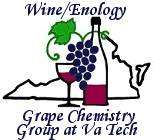 Enology
Notes #72, March 25, 2003
Enology
Notes #72, March 25, 2003
To: Regional Wine Producers
From: Bruce Zoecklein, Head, Enology-Grape Chemistry Group, Virginia Tech
Subject: Winemakers Technical Roundtable Meeting at Horton Vineyard, March 27
Winemakers Technical Roundtable Meeting at Horton Vineyard, March 27.
The following are some practical issues regarding malolactic fermentation (MLF), the subject of the upcoming Winemakers Technical Roundtable meeting at Horton Vineyard, March 27, beginning at 1:00 pm.
The duration of MLF can be a function of yeast strain. A main reason for this is the production of different concentrations of sulfur dioxide produced by different yeasts. Additionally, yeast strains vary in their impact on wine pH, which can impact bacterial growth.
Yeast strain impacts the concentration of polysaccharides produced during fermentation. This appears to have a stimulatory impact in lactic acid bacterial growth (Delteil and Jarry, 1992).
The duration of MLF and timing can impact wines sensorially. For example, in a study conducted by Delteil (2002), a red wine was split into two lots. One lot was inoculated with bacteria immediately following fermentation. The other was inoculated 25 days later, with the same strain and concentration of bacteria. The sensory profile of the first wine was superior. It had a lower concentration of chemical and herbaceousness, and a riper fruit character. Additionally, the early MLF wine had more body, and less bitterness.
Longer maceration results in quicker completion of MLF. This likely results from the elevation in pH and the increase in both polysaccharides and acetaldehyde (binds with sulfur dioxide) associated with extended maceration (Delteil, 2001).
There have been a number of studies suggesting strain differences among MLF bacteria, and their impact on wine sensory features. Strain difference can impact volatile compounds, impacting the varietal fruit, as well as palate features including body, astringency and bitterness.
Practical issues regarding MLF management, including the use of lysozyme, will be discussed at the upcoming meeting. See you there!
Subscription to Enology Notes. All past Enology Notes and Vintner's Corner newsjournals are posted on the Enology-Grape Chemistry Group's web site at: http://www.fst.vt.edu/zoecklein/index.html or http://www.vtwines.info/. Enology Notes are slightly different in content from the subscription based Vintner's Corner newsjournal.
To be added to the Enology Notes list serve send an email message to bzoeckle@vt.edu with the word "ADD" or "REMOVE" in the subject line.
Dr. Bruce Zoecklein
Professor and Enology Specialist
Head Enology-Grape Chemistry Group
Department of Food Science and Technology
Virginia Tech
Blacksburg VA 24061
Enology-Grape Chemistry Group Web address: www.vtwines.info or www.fst.vt.edu/zoecklein/index.html
Phone: (540) 231-5325
Fax: (540) 231-9293
Email: bzoeckle@vt.edu